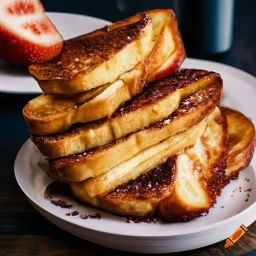Easy French Toast Recipe: Start Your Morning with a Flavorful Twist
“Looking for a mouthwatering French toast recipe? Our easy-to-follow guide will help you create the perfect breakfast treat. Try our delicious variation today!”
 Introduction
Introduction
Are you looking for a delicious breakfast option that’s easy to make and sure to please? Look no further than the classic French toast! In this article, we’ll guide you through a step-by-step process of preparing a mouthwatering French toast recipe. Whether you’re a beginner or an experienced cook, this guide will help you create a perfect batch of French toast every time. So grab your apron and let’s get cooking!
Table of Contents
1. Understanding the French Toast Basics
2. Ingredients You’ll Need
3. Step 1: Preparing the Egg Mixture
4. Step 2: Dipping the Bread Slices
5. Step 3: Cooking the French Toast
6. Step 4: Serving and Garnishing
7. Tips for Perfect French Toast
8. Variations to Try
9. Frequently Asked Questions (FAQs)
10. Conclusion
 1. Understanding the French Toast Basics
1. Understanding the French Toast Basics
French toast, also known as eggy bread or pain perdu, is a popular breakfast dish made by dipping bread slices into a mixture of beaten eggs, milk, and flavorings, and then frying them until golden brown. The result is a delightful combination of crispy edges and a soft, custard-like center.
2. Ingredients You’ll Need
To prepare a delicious batch of French toast, gather the following ingredients:
• Slices of bread (white, whole wheat, or brioche)
• Eggs (2-3, depending on the number of servings)
• Milk (1/2 cup)
• Vanilla extract (1 teaspoon)
• Ground cinnamon (1/2 teaspoon)
• Salt (a pinch)
• Butter or cooking spray (for frying)
• Maple syrup, fresh berries, or powdered sugar (for serving)
 3. Step 1: Preparing the Egg Mixture
3. Step 1: Preparing the Egg Mixture
In a shallow bowl or a pie dish, whisk together the eggs, milk, vanilla extract, ground cinnamon, and a pinch of salt. This mixture will form the base of your French toast. Ensure that all the ingredients are well combined.
4. Step 2: Dipping the Bread Slices
Heat a non-stick skillet or griddle over medium heat. Take a slice of bread and dip it into the egg mixture, allowing it to soak for a few seconds on each side. Make sure the bread is evenly coated with the mixture but not overly saturated.
5. Step 3: Cooking the French Toast
Add a small amount of butter to the preheated skillet or griddle. Place the dipped bread slice onto the hot surface and cook it for about 2-3 minutes per side, or until it turns golden brown and crispy. Repeat this process with the remaining bread slices, adding more butter as needed.
6. Step 4: Serving and Garnishing
Once the French toast slices are cooked to perfection, transfer them to a serving plate. You can garnish them with a dusting of powdered sugar, a drizzle of maple syrup, or a handful of fresh berries for added flavor and visual appeal. Serve the French toast warm and enjoy!
7. Tips for Perfect French Toast
• Use stale bread or day-old bread for better texture absorption.
• Customize your flavorings by adding a touch of nutmeg, cardamom, or orange zest to the egg mixture.
• For a richer taste, substitute some of the milk with heavy cream or half-and-half.
• To keep your French toast warm while cooking in batches, place the cooked slices on a baking sheet in a preheated oven at 200°F (93°C).
8. Variations to Try
French toast is incredibly versatile and can be adapted to suit different tastes. Here are a few variations you can experiment with:
• Stuffed French Toast: Create a pocket in each bread slice and fill it with cream cheese, fruit preserves, or Nutella before dipping and cooking.
• Cinnamon Sugar French Toast: After cooking, sprinkle the warm French toast with a mixture of cinnamon and sugar for an extra burst of flavor.
• Savory French Toast: Skip the vanilla extract and cinnamon in the egg mixture. Instead, add salt, pepper, and herbs like thyme or parsley. Serve with bacon or sautéed mushrooms for a savory twist.
9. Frequently Asked Questions (FAQs)
Q1: Can I use any type of bread for French toast? A1: Yes, you can use various types of bread such as white, whole wheat, or brioche. However, thicker slices tend to work better, as they absorb the egg mixture without becoming too soggy.
Q2: Can I make French toast ahead of time? A2: While French toast is best enjoyed immediately after cooking, you can keep the cooked slices warm in the oven for a short period. However, avoid storing them for too long, as they may lose their crispness.
Q3: Can I freeze French toast? A3: Yes, you can freeze French toast! Allow the cooked slices to cool completely, then place them in a single layer on a baking sheet and freeze. Once frozen, transfer them to a freezer bag or container. To reheat, simply toast them in a toaster or bake in the oven until heated through.
Q4: Can I use alternative milk or egg substitutes? A4: Yes, you can use alternative milk options like almond milk or soy milk. Additionally, you can explore egg substitutes such as mashed banana or applesauce for a vegan-friendly version of French toast.
Q5: How can I make my French toast extra fluffy? A5: To achieve a fluffier texture, you can separate the egg whites from the yolks. Whisk the yolks into the milk mixture as usual, and then beat the egg whites until stiff peaks form. Gently fold the egg whites into the mixture just before dipping the bread slices.
10. Conclusion
French toast is a delightful breakfast treat that’s easy to make and versatile enough to suit various tastes. By following this simple recipe, you can create a batch of French toast that is crispy on the outside, soft on the inside, and full of flavor. Don’t be afraid to experiment with different bread types, fillings, and toppings to make it your own. So why wait? Get your ingredients ready, and start enjoying the goodness of homemade French toast today!
Advantages of Eating French Toast
1. Nutritional Value
French toast can be a nutritious breakfast option when prepared with wholesome ingredients. The eggs used in the recipe provide a good source of protein, while the bread offers carbohydrates for energy. By opting for whole wheat or multigrain bread, you can increase the fiber content of the dish, promoting better digestion and satiety.
2. Versatility in Toppings
One of the great advantages of French toast is its versatility in toppings. You can personalize your French toast by adding a variety of healthy and flavorful toppings. Fresh fruits, such as berries or sliced bananas, offer essential vitamins and antioxidants. Additionally, you can include a sprinkle of nuts or seeds for added crunch and nutritional value.
3. Comforting and Satisfying
French toast has a reputation for being a comforting and satisfying breakfast option. The combination of warm, crispy bread and the sweet, custard-like center creates a delightful contrast in textures and flavors. This can provide a sense of comfort and satiety, making it an excellent choice for starting your day on a cozy note.
4. Easy to Prepare
Preparing French toast is relatively simple and requires only a few basic ingredients. It is a great option for those who prefer a hassle-free breakfast. With minimal effort, you can create a delicious and visually appealing meal that will impress your family or guests.
Disadvantages of Eating French Toast
1. Calorie and Fat Content
While French toast can be a tasty treat, it’s important to be mindful of its calorie and fat content. The addition of butter, oil, or cooking spray for frying can increase the overall calorie count. Furthermore, if you opt for a syrupy or sugary topping, it can significantly contribute to the dish’s calorie content.
2. Added Sugar
Traditional French toast recipes often call for a sprinkle of powdered sugar or a drizzle of maple syrup as a finishing touch. These sweet additions can contribute to an increased sugar intake, which may not be ideal for individuals watching their sugar consumption or managing conditions such as diabetes.
3. Potential for Overindulgence
The delicious taste and comforting nature of French toast can make it easy to overindulge. It’s important to practice portion control and mindful eating to avoid consuming excessive calories. Pairing French toast with a balanced side of fresh fruit or a source of lean protein can help create a more satisfying and well-rounded meal.
Welcome to our food recipe blog! At http://myhungryplanet.com/ , we share delicious and easy-to-make recipes to tantalize your taste buds. Whether you’re a seasoned chef or a beginner in the kitchen, we’ve got you covered with a wide range of recipes from various cuisines. From mouthwatering appetizers to decadent desserts, our blog is your go-to source for culinary inspiration. So, grab your apron and let’s get cooking! Oh, and before we continue, don’t forget to check out our other recipe for a scrumptious dish that is sure to impress. You can find it http://myhungryplanet.com/category/recipe/ Happy cooking!
? Hot Kitchen Product Sale Alert! Don’t Miss Out! ?
Discover the ultimate kitchen product sale extravaganza at https://hungryplanet.my.canva.site/ ! Get ready to transform your culinary experience with incredible deals on top-notch kitchen essentials. Hurry and grab these amazing offers before they’re gone!
Related Topic:-
french toast
french toast casserole
best french toast recipe
french toast bake
french toast sticks
easy french toast recipe
vegan french toast
 Introduction
Introduction 1. Understanding the French Toast Basics
1. Understanding the French Toast Basics 3. Step 1: Preparing the Egg Mixture
3. Step 1: Preparing the Egg Mixture